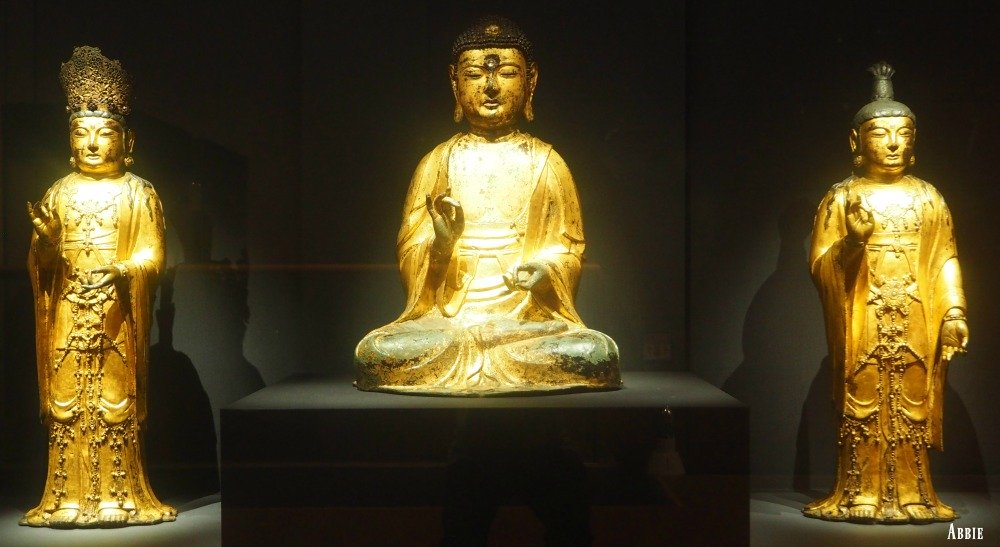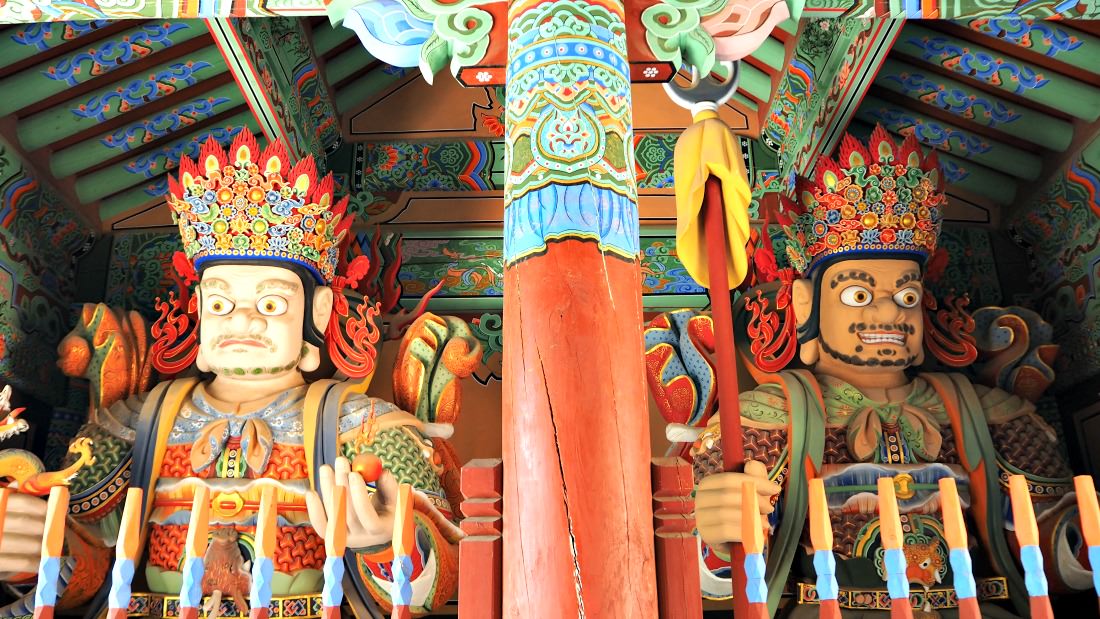Wolchulsan National Park
 Triad Buddha statues on exhibition at the National Museum of Korea
Triad Buddha statues on exhibition at the National Museum of KoreaIntroduction
Wolchulsan National Park is located in the South Jeolla Province of Korea. The park is home to a diverse range of wild animals and plants.
It also features remarkable scenic beauty with steep rocky peaks, lush forests, picturesque valleys and rivers, and various waterfalls. Visitors to the park can enjoy activities such as hiking, camping and bird watching in its pristine environment.
Wolchulsan Mountain is the main feature of the park and stands at an impressive 759 meters. The mountain is composed of steep, rocky peaks and lush forests. Visitors can experience various hiking trails that traverse through the area, offering breathtaking views of the surrounding landscape.
The Wolchulsan National Park also offers a variety of activities for visitors to enjoy. There are also several cultural attractions in the area such as temples and historical sites that offer insight into Korean culture and tradition.
Wolchulsan National Park is one of Korea’s most beautiful destinations. Its stunning landscape, abundant wildlife, and diverse range of activities make it an ideal destination for outdoor enthusiasts.
Whether you are looking to explore nature, or just relax and enjoy the views, Wolchulsan National Park is sure to provide a memorable experience.
wolchulsan national park
Wolchulsan National Park (Hangeul: 월출산국립공원, Hanja: 月出山國立公園) is a great mountain park located in Southern Jeolla Province (Jeollanam-do), South Korea.
This mountain range was designated as a national park in 1988. With a total of only over 56 square kilometers (21 square miles), Wolchulsan National Park is considered South Korea's smallest national park.
Wolchulsan can be roughly translated as “the mountain where the moon rises.” Some say its name also came from the mountain in Gangjin and Yeongam counties with the same name--Wolchul Mountain (‘san’ - mountain).
Cheonhwangbong Peak (over 800 meters high) is Wolchulsan’s highest peak. It is at the heart of the park from where you can observe the other beautiful peaks, each with unique and impressive features.
Beautiful Sights & Features
Dogapsa Temple
Dogapsa Temple is located near the Wolchulsan National Park’s parking area. It is an old but serene and pretty temple.
After passing by Dogapsa Temple area for around 20 minutes, you will begin to get a view of the park’s entrance area.
Gujeolbong Peak
One will begin to see this beautiful peak after walking for five kilometers from the main entrance.
Gujeolbong Peak is a pretty-much appreciated peak due to its shape like huge pots. They are called ‘pots’ because they contain water all year round.
Legend has it that a dragon used to live there.
Maae-yeorae-jwasang
The word means a “sitting statue of Buddha.” The sitting Buddha is designated National Treasure (No.144).
Passing the statue, you will find a trail leading to the peak which is in the midst of verdant forest with all classes of plant species under its canopy.
There are three more National Treasures located within the park. Also, you will find many interesting local cultural properties as well.
Top of Wolchulsan Mountain
Once you succeed and reach the top of the mountain, you will be very delighted. You will find a relatively flat and spacious granite rock that can accommodate around 300 hikers.
From that vantage point, you have incredible vistas of the park and the surrounding areas.
As you descend towards the other side of the mountain, you will be greeted by an arched bridge. The beautiful structure is around 120 meters above the ground.
Still, in the middle of the national park, you will find Sajabong Peak. You should not miss to see and admire the beauty of Chilchi Waterfall just to the left of Sajabong. (Literally, ‘saja’ means ‘lion’ and ‘bong’ means ‘peak’).
Chilchi (‘chil’ means ‘seven’) Waterfall is amazing; in fact, consists of seven separate falls one on top of the others. They are pouring down into the valley below the parking area.
 Guardians at the main gates of Korean temples
Guardians at the main gates of Korean templesTo Dogapsa and Muwisa Temples
On your way towards these two old temples, you will be trailing a path where a field of reeds is found.
The field becomes a spectacular and beautiful pleasing to one’s eyes, especially during the Fall Season.
Wolchulsan National Park offers a beautiful sunset in the west. It shows off pretty azaleas in the spring, cool and refreshing waterfalls in the summer, mesmerizing colors in the fall, and sparkling white snow that blankets the mountains and valleys in the winter.
Operation Period
The park is open all year round, except when there are emergencies and other local and weather conditions.
Call this number to inquire and ensure availability for hiking:
* Inquiry: +82-61-473-5210
Available Hiking Courses / Trails
Usually, restricted areas for hiking are indicated in various places in the park. Signs and guide maps are available at significant points.
Below, you will find the trails and areas that are open to the public...
- Cheonhwangsa Temple area <-8.6km-> Dogapsa Temple
- Cheonghwangsa Temple <-2.6km-> Tongcheonmun Intersection
- Sanseongdae Entrance <-2.6km-> Gwangamteo
- Geumreunggyeongpoda <-2.2km-> Baramjae
- Gyeongpodae Intersection <-1.5km-> Jongjuneungseon
- Cheonghwang Parking Lot <-0.92km-> Tapdong Mineral Spring
- Jukjeong <-0.6km->Woldaeam
- Hachi Village - Nuritjae <-1.6km-> Sajajeosuji
There are two natural preservation areas not open to the public: Janggunbong Peak (until 2026) and Dongwon Farm Miwangjae (until 2026). Hiking in these areas is strictly prohibited.
Longer Hiking Courses
The trails mentioned above are only short hikes and for describing only the best places to visit. Below is the real deal...
- Baram Waterfall (Mountain Ridge Trail)
- Gureumdari Bridge (Mountain Ridge Trail)
- Dogap District to Gyeongpodae District
- Gyeongpodae Round-Trip Course
Wolchulsan Park’s Facilities
As a popular hiking area and park, Wolchulsan is provided with facilities that cater to the needs of park visitors and serious hikers.
Here are the facilities and other features…
Entrance Fee
Entering into the park’s main gate is free for all visitors. However, if you explore some unique features and other cultural assets within the park, you might have to pay minimal charges for their upkeep.
Parking Area
A parking lot is available for those coming with private vehicles. Depending on the size of your vehicle, you will be charged from 2,000 Won to 7,500 Won.
Facilities & Centers
As a mountain park, Wolchulsan National Park is being maintained by paid government staff and officials who are stationed in specific areas within the park.
Offices and Ranger Stations
Wolchulsan National Park Office, Dogap Ranger Station
Information Centers
Cheonhwang Information Center, Gyeongpodae Information Center
Campsites
Cheonhwangsa Campsite, Gyeongpodae Campsite
Getting to Wolchulsan National Park
Once you are in the country, you can take any available public transport for Wolchulsan area. Some of the available routes, as your guide, are as follow...
By Public Bus
Go to Seoul Central City Terminal, then take an Intercity Bus to Mokpo City. This travel will take around 4 hours in total (including the 15-stop along the highway).
Then from Mokpo Intercity Bus Terminal, take a local bus to Yeongam Terminal which could take less than an hour.
Then from Yeongam Terminal, take another local bus or a taxi to Cheonhwangsa Temple where you can start hiking the park. A bus ride could take around 10 minutes.
Trains
In Seoul, take a subway (or bus) and get off at Suseo Subway Station. Then go to Suseo SRT and take the Suseo SRT-Mokpo train.
The travel time takes around 2 hours for 46-70,000 Won. To see the updated fare and time travel, please see the link below:
https://www.rome2rio.com/map/Seoul/Mokpo-Station
Approximate total travel time: 3 hours and 30 minutes.
Sources:
Korea National Parks website
Visitkorea.or.kr
----------------------------------------------------------------------
NOTE: This page will be (regularly) updated with my own travel experience of the park. The above information is based only on my research. So, keep in touch.
----------------------------------------------------------------------
Thanks for reading this article. I hope this is useful. Enjoy your trips.
- Home
- Korea National Parks
- Wonchulsan Park
Get Exciting Activities
Book one of our exciting activities today to experience the thrill of a lifetime! Take advantage of this opportunity and secure your spot in advance.
Hotel Map Guide
Find your affordable, accessible, and comfortable hotel in Seoul at Agoda.Com. See the hotel map below...
Hotel Booking Guide
Find affordable and amazing hotels on Agoda.com using the search box below. Book now to enjoy great discounts and save!







New! Comments
What do you think about this page? Leave me a comment in the box below.